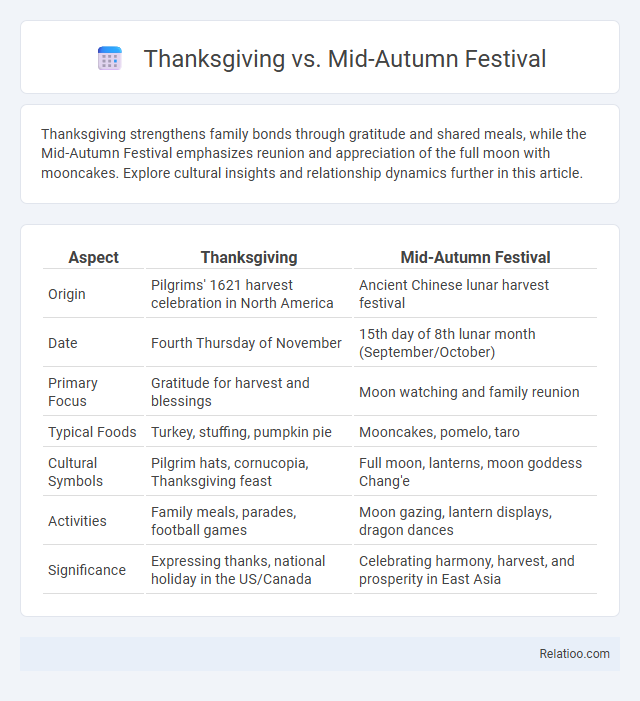Thanksgiving strengthens family bonds through gratitude and shared meals, while the Mid-Autumn Festival emphasizes reunion and appreciation of the full moon with mooncakes. Explore cultural insights and relationship dynamics further in this article.
Table of Comparison
| Aspect | Thanksgiving | Mid-Autumn Festival |
|---|---|---|
| Origin | Pilgrims' 1621 harvest celebration in North America | Ancient Chinese lunar harvest festival |
| Date | Fourth Thursday of November | 15th day of 8th lunar month (September/October) |
| Primary Focus | Gratitude for harvest and blessings | Moon watching and family reunion |
| Typical Foods | Turkey, stuffing, pumpkin pie | Mooncakes, pomelo, taro |
| Cultural Symbols | Pilgrim hats, cornucopia, Thanksgiving feast | Full moon, lanterns, moon goddess Chang'e |
| Activities | Family meals, parades, football games | Moon gazing, lantern displays, dragon dances |
| Significance | Expressing thanks, national holiday in the US/Canada | Celebrating harmony, harvest, and prosperity in East Asia |
Origins and Historical Background
Thanksgiving traces its origins to early 17th-century Plymouth settlers celebrating a successful harvest with Native Americans, symbolizing gratitude and cooperation. The Mid-Autumn Festival, dating back over 3,000 years to ancient China, honors lunar deities and celebrates the full moon, harvest, and family unity. Festivals worldwide often arise from cultural, religious, or agricultural traditions, reflecting societies' historical connection to nature, deities, and communal values.
Cultural Significance and Symbolism
Thanksgiving centers on gratitude for the harvest and blessings, celebrated primarily in the United States with symbolic elements like turkey and cornucopias representing abundance. The Mid-Autumn Festival, deeply rooted in East Asian cultures, honors the moon's fullness and family reunion, symbolized by mooncakes and lanterns conveying unity and prosperity. Your understanding of these festivals enhances appreciation for diverse cultural values, each reflecting unique historical and spiritual traditions through their symbols and rituals.
Key Traditions and Practices
Thanksgiving centers on gratitude and harvest, featuring a traditional meal of turkey, stuffing, and pumpkin pie shared among family and friends. The Mid-Autumn Festival highlights moon worship, mooncakes, and lantern displays symbolizing unity and prosperity. Your participation in these festivals embraces unique cultural rituals that celebrate harvests, family reunions, and seasonal changes.
Iconic Foods and Festive Meals
Thanksgiving highlights roasted turkey, stuffing, cranberry sauce, and pumpkin pie as iconic foods central to the celebratory meal. The Mid-Autumn Festival centers on mooncakes, which are symbolic pastries filled with lotus seed paste or red bean, often shared among family and friends. Various global festivals feature distinctive festive meals, such as Chinese New Year with dumplings and fish for prosperity, or Diwali with sweets like ladoos and savory snacks, emphasizing communal sharing and cultural traditions.
Family and Community Gatherings
Thanksgiving centers on expressing gratitude through family feasts, often featuring turkey and pumpkin pie, fostering close-knit community bonds across the United States and Canada. The Mid-Autumn Festival, celebrated primarily in East Asian cultures, emphasizes family reunions, mooncake sharing, and moon-gazing as symbols of harmony and togetherness. Each festival uniquely strengthens your connection to loved ones and broader community networks through shared meals and traditional rituals.
Rituals of Gratitude and Giving Thanks
Thanksgiving, the Mid-Autumn Festival, and various traditional festivals all center on rituals of gratitude and giving thanks, reflecting cultural values and seasonal abundance. During Thanksgiving, families gather for a feast featuring turkey and pumpkin pie to honor harvest and blessings, while the Mid-Autumn Festival involves mooncakes and lanterns symbolizing unity and appreciation for the full moon. Your participation in these celebrations connects you to communal expressions of thankfulness and cultural heritage, highlighting the universal human impulse to acknowledge prosperity and togetherness.
Seasonal Influences and Timings
Thanksgiving occurs in late November, reflecting the autumn harvest period in North America with seasonal influences centered around gratitude and family gatherings. The Mid-Autumn Festival, celebrated in September or October, aligns with the full moon and harvest season in East Asia, emphasizing moon worship and reunion themes. Your experience of these festivals varies as each is timed according to regional agricultural cycles and cultural lunar or solar calendars.
Artistic Expressions and Decorations
Thanksgiving features rich artistic expressions through intricate pumpkin carvings, autumn-themed crafts, and warm, rustic decorations symbolizing gratitude and harvest. The Mid-Autumn Festival showcases vibrant lantern-making traditions, mooncake artistry, and colorful displays that highlight lunar symbolism and family reunion themes. Your celebration of these festivals can be enhanced by incorporating culturally unique decorations, reflecting each event's distinct artistic heritage.
Modern Adaptations and Global Influence
Thanksgiving in the United States has evolved into a celebration featuring diverse cultural cuisines and virtual gatherings, reflecting globalization and digital connectivity. The Mid-Autumn Festival, primarily celebrated in East Asia, incorporates modern elements such as lantern parades on social media and commercial mooncakes with innovative flavors appealing to younger generations worldwide. Global influence has transformed these festivals into inclusive events, blending traditional rituals with contemporary practices to foster cross-cultural appreciation and participation.
Comparative Insights: East Meets West
Thanksgiving and the Mid-Autumn Festival both center on gratitude and family reunions but differ culturally and seasonally; Thanksgiving, rooted in American history, emphasizes harvest thanks in late November, while the Mid-Autumn Festival, celebrated in East Asia, honors the moon and harvest in September or October. Festivals worldwide reflect diverse customs, foods, and symbolic meanings, highlighting how Your celebrations blend traditional values with regional influences. Comparing these festivals reveals unique symbols like Thanksgiving's turkey and pumpkin pie versus mooncakes and lanterns in the Mid-Autumn Festival, showcasing how East meets West through shared themes of thanksgiving and unity.

Infographic: Thanksgiving vs Mid-Autumn Festival
 relatioo.com
relatioo.com